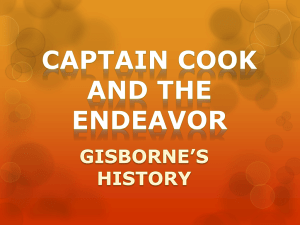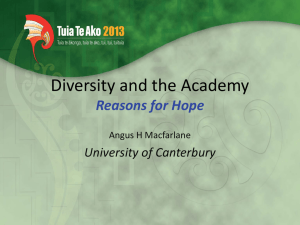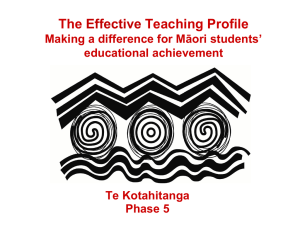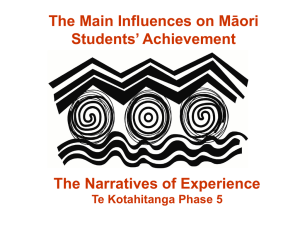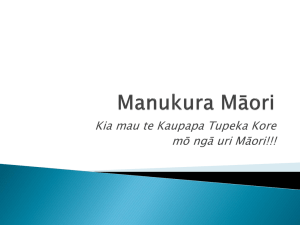2011 Research Colloquium presentation
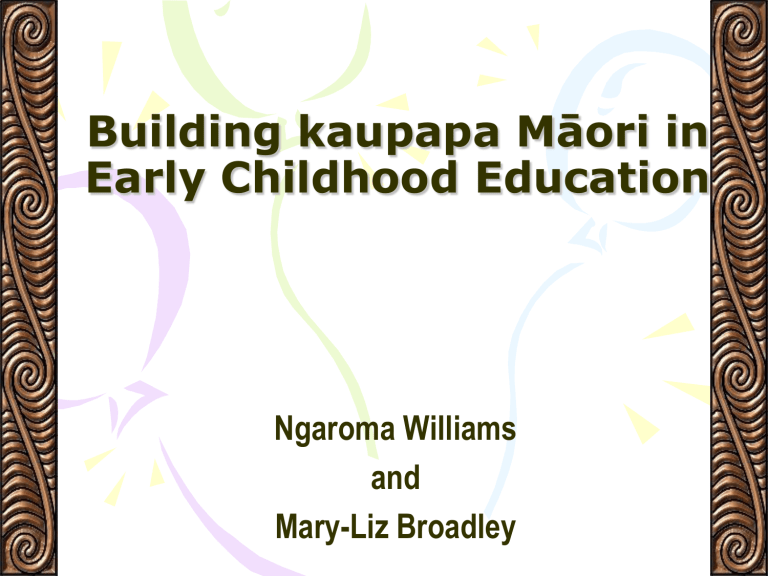
Building kaupapa Māori in
Early Childhood Education
Ngaroma Williams and
Mary-Liz Broadley
Mihimihi
E tu kahikatea
Hei whakapae ururoa
Awhi mai awhi atu
Tatou tatou e
Tatou tatou e
Stand like the kahikatea (tree)
To brave the storm
Embrace one another
We are one together
Research Objectives
Objectives are:
• To support Māori and non-Māori students, registered and qualified teachers to work more effectively and appropriately with all children in early childhood education Aotearoa, New Zealand bicultural contexts;
• Te develop a model of best bicultural practice and tools for the achievement of the above.
Participants samples and data collection methods
1. Online surveys:
Subject Group 1 (SG1): Year 3 Students Teachers (n=24)
Subject Group 2 (SG2): OPNZ Regional Lecturers (n=13)
Subject Group 5 (SG5): Tertiary teaching providers (n=3)
2. Kanohi ki te kanohi focus group sessions:
Subject Group 3 (SG3): Year 2 Student Teachers (n=96)
Subject Group 4 (SG4): Tangata Whenua (n=4)
Subject Group 7 (SG7): Year 3 Professional Practice Student
Teachers (n=42)
Participants samples and data collection methods continued…
3. Kanohi ki te kanohi video and/or audio recorded interviews:
Subject Group 4 (SG4) Tangata Whenua (n= 15)
Marae-based iwi from:
Dunedin, Wellington, Auckland, and Rotoura.
4. Telephone Interviews:
Subject Group 6 (SG6): ECE Graduate Teachers (n=21)
Research Findings
A thematic analysis of research findings was undertaken and six main themes identified, namely:
• Accountability
• Cultural identity
• Cultural competence
• Barriers to te reo me ōna tikanga
• A need for resources
• Ako (or active hands-on learning that is embedded in culture).
Research findings links to literature
Durie (2003) provides further support or clarification to the Māori
Education Framework developed in 2001 (Hui Taumata
Mātauranga).
Durie (2003) states that Māori experience similar fortunes and misfortunes to other New Zealanders however, the essential difference is that Māori live at the interface between two worlds, between te ao Māori (the Māori world) and te ao whānui (the wider global society).
This interface is unique – it is unique to the people who live in
Aotearoa and unique to the NZ education system.
This research project is aimed at growing that space at the interface and in keeping with the underpinnings inherent in
Te Whāriki.
Main research findings summarised:
• ECE sector requires support to understand and implement kaupapa Māori principles, protocols, and practices.
• Shift required from biculturalism to bicultural development tools required.
• ‘Paddling the same waka’ – complementary bicultural tools required within ECE sector.
• Māori mentorship required for te reo me ōna tikanga.
• Hands-on learning tools: (waiata booklets, etc) required to support bicultural development.
• Pākehā need support to unmask their cultural identity.
• Big Picture: A set of definitive cultural competencies and measurement tools to further the creation of biculturalism kaupapa and associated resources.
Implications for practice
Implications for practice are explored and a set of tools to facilitate bicultural development have been drafted.
The tools are:
• A kaupapa Māori Maramataka (Tikanga Maori theoretical framework calendar)
• Set of Student Teachers pamphlets (n=10)
• Set of Graduate Teachers pamphlets (n=5)
• Set of Lecturer Guidelines Booklet
• Set of Lecturers Resources Booklet
• 2x Posters for ECE services and centres: Outlining iwi names throughout the motu, and a generic outline on pōwhiri protocols.
• ECE Waiata booklet.
Where to Next?
Submission to Ako Aotearoa for peer review on research report and bicultural tools.
Conference presentations:
• Early Childhood Associate Teachers Hui (2nd July, 2011);
• Te Tari Puna Ora o Aotearoa ECE Conference (22 nd July,
2011),
• and abstract to be submitted for NZARE conference (29 th
November, 2011).
Finalisation of tools/research report for dissemination.
Thank You and Questions
Thank you to Ako Aotearoa for the national funding grant,
Thank you to our participant samples,
Thank you to our project mentors,
Thank you to our whānau, and
Thank you to Open Polytechnic and Te Tari Puna Ora o Aotearoa

